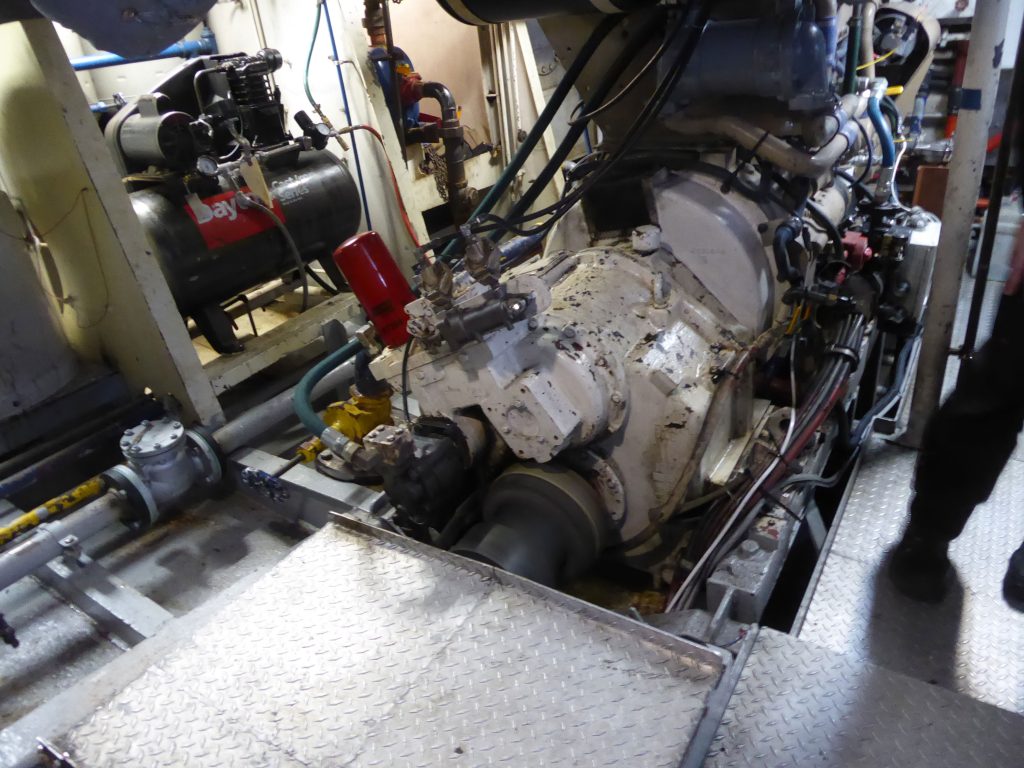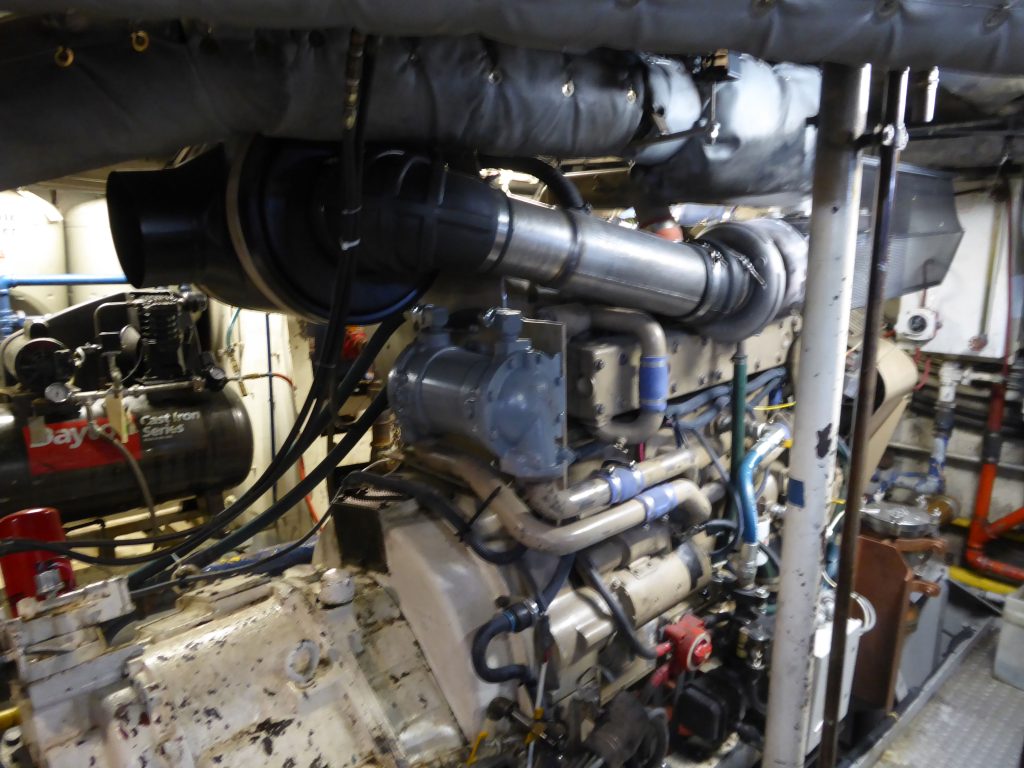|
Listen to this post
|
Wednesday, September 21, 2022. We passed through Queen Charlotte Sound overnight. This is part of the Inside Passage shipping route. The waters were rather choppy overnight as we were not shielded from the Pacific Ocean as much as when we were traveling through Hecate Strait and shielded by various islands to the south of the Dixon Entrance.
As with previous days, I was awake at 6 a.m. and took another photo from the bow of the Wilderness Discoverer. We are nearing the end of our voyage. We continue our passage past British Columbia. As yesterday, we are unable to visit the shore.
After another great breakfast, we took a tour of the engine room of the Wilderness Discoverer at 9:20 a.m. Jake (the chief engineer) gave our tour. Among many facts, we learned that the Wilderness Discoverer was originally christened the Mayan Princess (built in 1991). The ship was originally used for river cruises. The bridge area could be raised and lowered manually when the ship was first built. This allowed for passage under low bridges on selected tours. That structure is now permanently anchored and significantly upgraded.
Here are a couple of views of the engine (and engine room). FYI – those who know me realize I am well over 6 feet tall. This area was a “tall man’s torture.” Seems like I was hunched over the entire time. Yes, we all had to wear hearing protection while in the engine room. Questions and discussion happened before and after the tour.


The Wilderness Discoverer carries 6,700 gallons of diesel fuel. On an average day, 800 gallons are consumed. Yes, in theory, the ship can travel for a little more than 8 days before refueling. The ship generates its own power (obviously), but also has a 480 volt step down transformer when anchored dockside. There are two main engines and two generators. There is also a backup generator in the event of complete engine failure. For every 3 engine revolutions, the propeller turns once (yes, there are two propellers). The transmission handles this reduction.
Jess (one of our guides) discussed “Unlovable Sea Creatures” at 10:30. She discussed acorn barnacles as the first part. They are arthropods and begin life as zooplankton. Once they settle down, they are cemented to a given object and do not venture again during their life time. There are over 1,000 species of barnacles. Some scientists and engineers are investigating the cement they use for possible enhancements to cement used in dentistry (obviously, it stands up to water). Barnacles are filter feeders and have 6-8 hard plates protecting the animal. We were reminded again that acorn barnacles have the largest penis to body size ratio in the animal kingdom. They are hermaphroditic so they can mate with their nearby neighbors. According to a U.S. Navy study, barnacles can increase the weight/ drag on a ship by up to 60%.
Jess next discussed the lumpsucker. This is a group of marine fish found in cold waters (such as those off Alaska). They are poor swimmers and often feed on worms, molluscs and jellyfish.
Decorator crabs were also mentioned. They have hooks like Velcro and camouflage their bodies. When they change to a larger shell, they move the decorations to their new shell.
Jess also reviewed brittle stars. They have 5 sets of jaws and 10 pouches. They digest their food outside their body then ingest the nutrients and store in their pouches. If they lose an arm, they can regrow it.
We also learned about the egg yolk jellyfish. Although short lived, they eat other jellyfish. The Lion’s Mane jellyfish has 8 clusters of tentacles. The egg yolk jellyfish has 16 clusters of tentacles.
The vampire squid was also mentioned. This is often found in warmer waters. It likes to live in the dark, deep ocean. It has neutral buoyancy. It is bio-luminescent.
The slender seapen (a soft coral) was also mentioned. These are found in Mediterranean waters and some places in the mid-Atlantic. They are colonial polyps and can live up to 100 years.
We also saw photos of the geoduck. This is found in the waters off Alaska and is the largest burrowing clam in the world. They have been recorded living up to 168 years and can grow to 3 feet in length. One typically only sees the tip of their siphon (the rest of the animal is buried in the muck). The female can produce up to 5 billion eggs. Evergreen State College (Washington State) has the geoduck as their mascot. It is named Speedy.
Pyrosomes were also mentioned. These are colonial tunicates. Their cone shaped colonies can be up to 60 feet in length. They are bio-luminescent and have been recorded as far north as Alaska. Fish can live inside these colonies.
Jess also mentioned the giant isopod. They are known from cold deep waters (both Atlantic and Pacific Oceans). We saw their relatives on an eco meander of tidal flats at North Sandy Cove. Giant isopods can grow up to 2 feet in length. They have two sets of antennae and 7 sets of legs. Where they live, the sunlight is 1/1 millionth of the intensity we see at the ocean’s surface.They are deep sea scavengers. One specimen lived for over 5 years in captivity without a meal.
Giant siphanophores and giant ostracods were also discussed by Jess. She did her best to make us aware of the incredible diversity of life in the waters around Alaska and inform us why all these species are important to life on our planet.
During the early to mid-afternoon, we participated in a murder mystery hosted by the guides and crew. I was asked to act in the role of Port Authority Inspector Bullet and was given a series of questions and tasks to perform. The majority of guests had to figure out “who done it.” Once the suspects were reviewed, I provided an overview of how I “solved” the case and arrested the murderess (no, it was not the butler this time). Altogether, we had a good time acting in various roles and trying to figure out the “crime.”
Just as we were sitting down for dinner, we were alerted to a large group of Pacific White Sided Dolphins. The captain reported this was the largest pod he had ever seen from this ship. Here is a short video of what we saw. The ones closest to the ship appear first on this video clip.
September 22 will be our last full day on the Wilderness Discoverer. We arrive in Seattle in the early morning of September 23 and depart for Illinois later that evening. I will be posting more about our tour of Sucia Island on September 22 soon.


